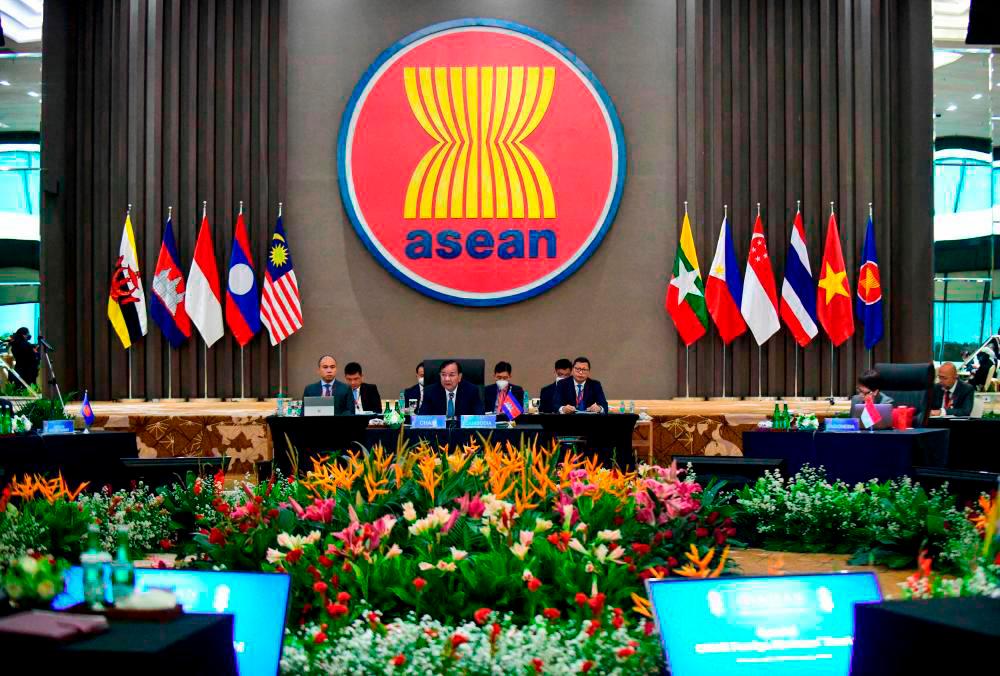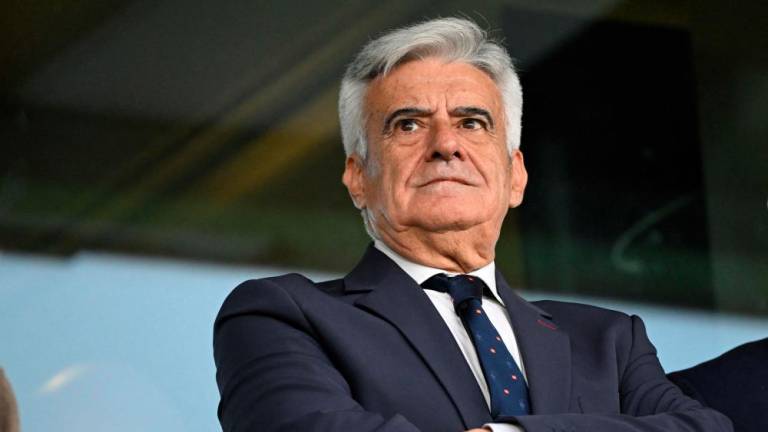THE recently concluded 42nd Asean Summit and Related Meetings in Indonesia remain the most critical crossroads for the immediate and long-term relevance and fate of Asean’s role in the region and beyond.
It exposes the most consequential crossroads with the lingering Myanmar debacle, unchecked tensions in the South China Sea, futile efforts for conflict prevention mechanisms, growing autocratic trends and disregard for human rights and other structural economic and geopolitical challenges, both cumulatively and further eroding Asean’s relevance, and exposing its deep-lying systemic weaknesses.
Asean was born out of a common fear of communism and external threat, and it remains the same for now.
However, the capacity to stand up to external threats from a collective joint deterrence and capacity point of view remains lost.
Indonesia will want to be seen as the ever-strong Asean leader and will want to take the lead in solving the Myanmar issue and in providing a clear platform and guidelines for South China Sea stability through a fast-tracked Code of Conduct (CoC) and a flurry of backdoor diplomacy for Myanmar.
It races against time and pressure to be seen as the most important regional and Asean leader, fresh from its G20 and global diplomatic success and would want to set the right tone before handing over to Laos, knowing well that by then the momentum might drop due to entrenched affiliation with Beijing and the potential pressure applied, as happened previously.
The Myanmar crisis and the growing tensions in the South China Sea are just two of the main indicators highlighting the failed approach of Asean in being limited by its inability to exert credible and solid measures. Jakarta realises this and so do other member states.
However, decades of stable status quo benefit derivation have created a common reluctance for significant shifts that would alter regime and regional security.
Historical regional cohesiveness in the region is primarily tied to trade and economic relativity and common yearning for security assurances.
The region is primarily shaped by economic and security importance, and openings for value-based and normative moral high ground for strong value-driven developmental essence are inadequate, unlike the European Union.
The region remains trapped by its own ignorance and utopian belief of its decades-old Asean Way approach and de-escalation of conflict through idealistic dependence on a non-confrontational approach and conflict prevention mechanisms through its different tiers and channels of dialogues.
Fears and wariness on China’s ambitions for the region, the quest to deny the West’s containment foothold in the region, the agenda in the South China Sea and the fallout of a full-blown Taiwan conflict, all create a perfect firestorm for both a declining impact of dialogue building efforts and the efficacy of confidence-building measures.
The West sees Asean as a lost cause in standing up against China and containment measures, while China wants Asean to remain in its status quo of neutrality, which means a freer option for China and a denial of space for the West.
Asean has repeatedly yearned for stability and status quo, in fear of a repeat of the Cold War divide and has created a flurry of mechanisms from the Treaty of Amity and Cooperation to the Asean Regional Forum and Southeast Asia Nuclear Weapon-Free Zone, among others.
However, this desired stability and peace has failed to materialise and the efforts have been threatened by the growing security dilemma and eventual arms race in the scramble for survival.
It cannot shed the trap of its founding principles and cannot afford to intimidate Beijing, while at the same time cannot solicit greater Western assurances either.
It remains trapped in its own worst game.
Asean has no capacity in hard or soft power to push for greater deterrence in order to secure its aim of stability in the region and will need external involvement and support.
Ironically, this will also break its own yearning for neutrality.
Years of Asean, regional strategic ambiguity, and strategic status quo maintenance have only provided a three-pronged result.
Firstly, it gives Asean the weakest returns and makes it even weaker with its trapped dogma and inability to provide credible solutions apart from the futile preventive mechanisms and confidence-building measures.
Secondly, it denies the full space needed for the West to galvanise collective regional cohesion and unity in creating a more able and credible shield and deterrent effectiveness.
Thirdly, it gives Beijing the biggest space and green light to further deepen its hard power postures and build on the increasing pie of influence and dominance in the South China Sea and the region.
The divide is apparent and growing as a result of the continental state grip (Laos, Myanmar and Cambodia) and the archipelago states (Malaysia, Singapore, Indonesia and the Philippines).
The region and Asean bask in the false sense of security from its avoidance of the hard truth and in refraining from directly challenging the risks in the region while hoping for a tacit Western counterbalancing act, especially in direct economic and trade support.
While the region has no qualms in being quick to embrace Regional Comprehensive Economic Partnership, the Belt and Road Initiative and direct economic overtures from Beijing, it faces a reluctant move to quickly embrace the Indo-Pacific Economic Framework for Prosperity (IPEF).
The IPEF is no match for its Chinese counterparts in terms of capital and trade capacity, and it does come with the moral high-ground values of labour standards, climate initiatives, normative democratic adherence and human rights.
All these are as unappealing to the region as a carrot is to a lion.
Declining deterrence impact will only worsen the depth of the arms race and further weaken the region’s collective resolve.
There is only so much the returns from Track I and II diplomacy can do if policymakers are reluctant to initiate bold changes to the set-up.
Hypocrisy and self-trap are laid bare, from the chastising of Washington for doing so little for Asean financially and economically but continuing to yearn for its defensive support, to pushing for deeper Washington trade commitment but boasting of its strict neutrality approach.
Asean needed external capacity to effectively enforce binding agreements in the future CoC or to keep United Nations Convention on the Law of the Sea adherence, but cannot afford to directly solicit this hard power deterrence and to maintain Asean’s concept.
Direct bilateral defence engagement and overtures and agreements are meant to secure individual states but will also give the region assurance and credible hard power deterrence.
Asean needs to change its principles and be bold in calling out law-defying behaviours by external parties to ensure that it walks the talk of maintaining regional stability.
Failure to address the current systemic shortcomings will see it fade into irrelevance.
The founding principles of non-interference and consensus decision-making have held member states together, forming a platform for autocrats, monarchs and democracies.
These principles assured the regime’s survival and security from the prying interference and influence by external parties and Asean.
These also serve as the needed assurance against third-party and external influencing factors and the need to cede sovereignty in certain segments to a supranational entity such as the EU.
However, the negative implications have been proven to serve more regional short-term interests and individual internal regime security more than future long-term collective interests.
Mutual distrust and mistrust, economic disparity, intra-trade deficiencies, redundancy and internal peer competition are some of the many structural deficiencies affecting Asean.
The returns from Asean affiliation as a grouping are dwindling in the long term, as member states seek external support individually to safeguard their survival.
External moves on individual states, including Japan’s Official Security Assistance, the upcoming potential Japan-Philippine-US alliance, individual direct bilateral engagement by external powers and others, all reflect the failed efficacy of Asean.
It has also given rise to various mini-lateral engagements, each with a specific tailor-made agenda in upping the survival interests of states.
Erosion of trust and stability in expectations and predictions of behaviours have further pushed member states to seek their own survival and assurances, giving rise to an arms race and a perpetual security dilemma.
Asean remains ill-equipped to handle the fallout from the South China Sea or the potentiality of a full-blown Taiwanese conflict.
The Asean Outlook on the Indo-Pacific offers nothing more than the usual parameters of safe play and continuous dependence on futile past efforts.
Harping on diplomatic moves through quiet and backdoor approaches and expanded dialogue mechanisms will only provide temporary cooling-off measures without tackling the root causes of the regional security dilemma, arms race and prisoner’s dilemma.
Asena now faces a critical crossroads and a tough choice, it has been trapped between a rock and a hard place for decades but lacks the audacity to implement significant changes.
It wanted to remain neutral and hoped that this would prevent the worst outcome and bring desired stability, but has persistently failed.
Asean members will prioritise their own national survival and interests above the interests of the region and the grouping, with little interest to commit more than desired, especially regarding the political survival of the ruling regimes and governments.
Little incentivisation efforts can be seen in chasing the regional standard of imposing greater rules, criteria and norms in setting the high standards and concepts of regionalism as is the case of the EU.
Lacking a rewarding, resilient and sustainable future and returns from the regional grouping in the long-term projection, member states find better stature and assurances from the existing external power that provides these lifelines and assurances.
The time is now for Asean leaders to be fully committed and open to admitting past mistakes, and for them to chart their legacy to enact credible changes that will ensure the region’s future sustainability and survival.
It will not be their legacy alone, as it will provide lasting assurances and legacies for the nations.
Collins Chong Yew Keat is a foreign affairs and strategy analyst at Universiti Malaya. Comments: letters@thesundaily.com










